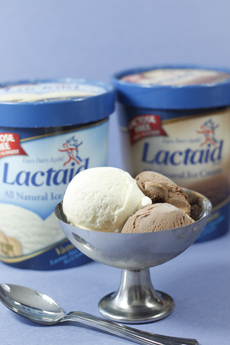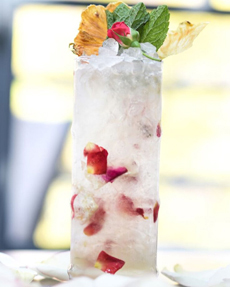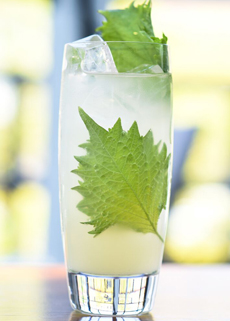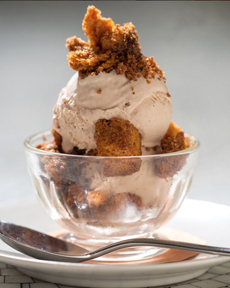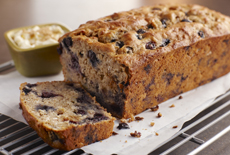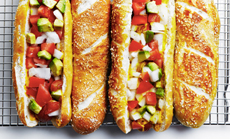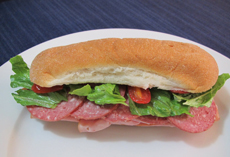|
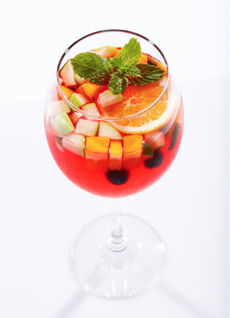
[1] Saké, shochu and lychee liqueur combine with fruit to create Saké Sangria from Kabuki restaurants (photo Kabuki | © Flavor & The Menu).
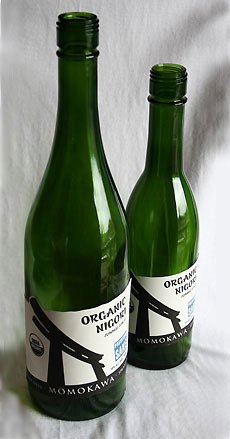
[2] Organic saké from SakéOne, brewed in Portland, Oregon (photo © SakéOne).

[3] Haamonii shochu, a premium brand Here’s more about it (photo by Katharine Pollak | © The Nibble).
|
|
On weekends, we try the cocktail recipes we publish. It’s tough work, but someone has to do it.
Last weekend’s cocktail was an amped up version of a saké-based sangria from Kabuki restaurant. Saké, Japanese rice wine, is substituted for the red or white wine in a Spanish-style sangria (here’s the history of sangria).
But that’s not all: This recipe adds sochu (also spelled shochu), a distilled spirit like vodka, but with a much lower proof.
We’ve never been to a Kabuki restaurant. They’re located in Southern California, Phoenix, and Las Vegas.
But after we perused the innovative sushi on their Facebook Page, we put it on our “must go” [when in the area] list.
Until then, we adapted a sangria recipe from Kabuki’s Master Saké Sommelier, Yuji Matsumoto.
Matsumoto’s Saké Sangria is a long-time favorite at the restaurant. It started as a limited-time-only drink, but was such a hit that it became a mainstay on the menu.
The recipe is below, but first:
WHAT IS SAKÉ SANGRIA?
Made with seasonal fruits, saké, shochu, and lychee liqueur, the drink is light and refreshing—just right for summer.
If you don’t want to buy sochu, use the vodka you have—especially a fruit-flavored or vanilla vodka.
Kabuki Signature Saké Sangria (fresh fruits, sake, shochu, grapefruit & cranberry juice)
RECIPE: KABUKI-STYLE SAKÉ SANGRIA
This recipe is an approximation: We didn’t get the recipe from Kabuki.
However, sangria recipes are very versatile: You can use different ingredients in different proportions.
Want pineapple or cantaloupe? Toss it in!
Want more juiciness? Add cranberry, grapefruit, pomegranate, or whatever juice you favor.
No lychee liqueur or elderflower liqueur like Saint-Germain (which tastes much more lychee-like than the SOHO Lychee Liqueur we tried)? Use Grand Marnier.
Other additions/substitutions: plum wine, hibiscus syrup, starfruit, fresh lychees in season, and so on.
Since it’s summer, we used summer fruits. In the fall and winter, we’ll switch to apples, pears, and blood oranges.
Prep time is 5 minutes, the infusion is 8 hours or longer. Kabuki infuses the fruits for 72 hours!
Ingredients For 5 Cocktails
1 plum, pitted and sliced
1 nectarine, pitted and sliced
1 pint strawberries
1 bottle 750 milliliters Japanese saké
1/4 cup sochu
1/4 cup lychee liqueur
Optional: Ice cubes
Optional garnish: starfruit slice, orange slice, fresh blueberries, etc.
Preparation
1. ADD the fruit to a pitcher and top it with the liqueur, saké, and shochu. Gently stir, cover, and allow the fruit to marinate for 8 hours or longer. (At Kabuki the sangria is infused for 72 hours!)
2. TASTE and adjust the shochu and liqueur as desired.
3. GARNISH as desired and serve in a red wine glass.
|
WHAT IS SOCHU?
Sochu, also spelled shochu, is a neutral grain spirit like vodka. But at half the proof of vodka, it’s a great solution to keep a crowd sober, longer.
Shochu has a 24% alcohol content (double the alcohol content to get the proof), compared to vodka at 40% and saké at 15%.
If you use vodka often, we highly recommend trying it. Here’s more about sochu.
WHAT IS KABUKI?
Kabuki is a form of traditional Japanese theater that originated during the 17th century, during Japan’s Edo Period.
Theater troupes dressed in extravagant costumes and supernatural makeup, and acted stories of love, moral conflicts, and historical events.
_____________________
*Thanks to Kabuki and Flavor & The Menu for the inspiration.
CHECK OUT WHAT’S HAPPENING ON OUR HOME PAGE, THENIBBLE.COM.
|

